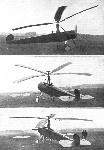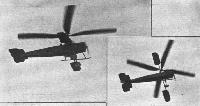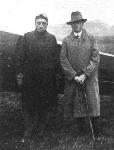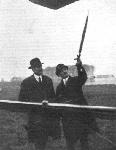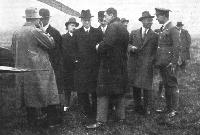
Cierva (автожиры X. Сиервы)
<...>
В июле 1923 года взлетел автожир С.5 с аналогичным мотором и трехлопастным несущим винтом. После этого Сиерва, ранее финансировавший свои работы из частных источников, получил субсидии от правительства Испании.
Его следующая модель С.6 стала началом серии удачных автожиров - так назвал Сиерва свои конструкции. Этот термин должен был использоваться только для машин Сиервы и обладателей его лицензий.
Автожир С.6А с фюзеляжем биплана Avro Type 504K и ротативным мотором Rhone 9Ja взлетел в мае 1924 года. На лонжеронах консольной балки были установлены элероны. Четырехлопастный несущий винт диаметром 10,97 м имел горизонтальные шарниры. При помощи троса его можно было раскрутить на земле до 60 обор/мин, таким образом, укорачивая разбег при взлете. Подъем машины в воздух происходил при достижении скорости вращения винта в 140 об/мин. Первый полет автожира состоялся 12 декабря 1924 года на расстояние 12 км между двумя аэродромами Мадрида - Куатро Вьентос и Хетафе. Был также создан автожир С.6В с аналогичным мотором.
В октябре 1925 года Сиерва привез аппарат С.6А в Британию по приглашению директора научных исследований Министерства авиации. После демонстраций в испытательном центре в Фарнборо Министерство заказало несколько автожиров для оценки в британских ВВС. Контракт на их изготовление отдали фирме "A.V. Roe".
Обозначения Avro Type 574 и Type 575 присвоили аппаратам Cierva С.6С и C.6D. Каждый из них оснащался ротативным мотором Clerget мощностью 130 л. с. (97 кВт). Первым взлетел С.6С 19 июня 1926 года, 29 июля взлетел и C.6D. С.6С разбился в аварии в январе 1927-го, когда лопасть несущего винта оторвалась на высоте 37 м, но пилот почти не пострадал. C.6D стал первым двухместным автожиром. В сентябре его облетал в Берлине Эрнст Удет.
Этот аппарат Avro Rota Mk I состоял в 1943-1944 годах в британской 529-й эскадрилье. Он использовался, главным образом, для калибровки береговых РЛС. В боевых действиях не участвовал, хотя и был практически неуязвим для вражеских истребителей благодаря своей исключительно высокой маневренности.
Обозначение С.7 присвоили двум автожирам Сиервы, построенным в Испании Хорхе Лорингом и полетевшим в 1926 году. Аппарат С.7 имел V-образный мотор Hispano-Suiza мощностью 300 л.с. (224 кВт). Его показали на авиашоу в Мадриде.
<...>
Описание:
- Cierva (автожиры X. Сиервы)
- Flight, October 1925
A NEW TYPE OF FLYING MACHINE
Фотографии
-
Air Enthusiast 2003-07 / N.Price - Honouring a pioneer
Cierva C.6 reproduction, built in 1992 for the Seville Exhibition.
-
Air Enthusiast 2003-07 / T.Hiett - Cierva's rotating wings
The C.6A as demonstrated by Frank Courtney at Farnborough in 1925.
-
Flight 1926-07 / Flight
The "Autogiro" (130 h.p. Clerget) The invention of a Spanish engineer, Senor de la Cierva, the "Autogiro," which will be seen at Hendon has been constructed in this country by A. V. Roe & Co., it being perhaps significant that Mr. A. V. Roe, one of the earliest pioneers of British aviation should pioneer a modern venture. The "Autogiro" has a rotating windmill in place of wings, and differs from the helicopter in that the lifting surfaces are not driven directly by the engine but by the air forces acting upon them. Propulsion is by an ordinary airscrew. At present the "windmill" is hand started but later mechanical starting will be fitted.
-
Aeroplane Monthly 1979-05 / P.Capon - Cierva's first autogiros (2)
The C.6 at Cuatro Vientos in 1924. This autogiro, which used the fuselage of an Avro 504K, was produced by the Spanish Air Force workshops.
-
Flight 1925-10 / Flight
THE CIERVA "AUTOGIRO": Front view. A mechanic may be seen winding the starting cable around its supports on the wings.
-
Aeroplane Monthly 1979-05 / P.Capon - Cierva's first autogiros (2)
A larger-diameter rotor was one of the distinguishing features of the C.6bis. Also visible are the “pegs” beneath the blades on which the starting rope was wound.
-
Flight 1925-10 / Flight
THE CIERVA "AUTOGIRO": These three views show admirably the action of the four-bladed lifting screw or windmill. In the lower view the machine is at rest on the ground, and the wings are drooping slightly.Above, the windmill has been started by means of a cable and has acquired a certain amount of speed, the the machine having just started its run. In the top photograph, the machine is seen shortly before "unsticking," the lifting planes having started to rise under the action of the lift. This is particularly noticeable in the wing pointing forward in the first photograph.
-
Flight 1925-10 / Flight
THE "AUTOGIRO": Two views of the machine in flight. Note how the high tip speed of the windmill beat our photographer.
-
Flight 1925-10 / Flight
The "Autogiro," piloted by Capt. Courtney, making an almost vertical descent.
-
Flight 1926-12 / Flight
Регистрационный номер: J8068 [5] A "STAR TURN" AT THE R.A.F. DISPLAY: The extraordinary Cierva "Autogyro" making one of its remarkable vertical descents.
-
Aeroplane Monthly 1974-09 / ??? - Hendon Pageantry 1920-37
Регистрационный номер: J8068 [5] The Cierva Autogiro at the 1926 pageant.
-
Air Enthusiast 2003-11 / Round-Out
Регистрационный номер: J8068 [5] Pleasant view of Cierva C.6C J8068 (complete with 'New Type Park; number 16) performing at Hendon, 1936.
-
Flight 1926-07 / Flight
Регистрационный номер: J8068 [5] ROYALTY INSPECTS THE MACHINE PARK AT THE R.A.F. DISPLAY: The centre of interest is the Autogyro. In this group will be seen the King and Queen, King Alfonso and the Queen of Spain, the Duke of York, Sir Geoffrey Salmond, Sir Hugh Trenchard and Sen. Cierva.
-
Air Enthusiast 2003-07 / T.Hiett - Cierva's rotating wings
Регистрационный номер: J8068 [5] C.6C J8068 demonstrating at the Hendon Air Pageant, 1926.
-
Air Enthusiast 2003-07 / T.Hiett - Cierva's rotating wings
The C.6D at Tempelhof in September 1926.
-
Aeroplane Monthly 1996-04 / Personal album. Civil
The Cierva C.6D Autogiro, alias the Avro 575, first flew in the hands of Frank Courtney on July 29, 1926. Powered by a 130 h.p. Clerget 9Bh, the two-seater was the first successful passenger-carrying Autogiro as was demonstrated on July 30 of the same year when Courtney carried Juan de la Cierva. Afterwards stub wings with ailerons were fitted, along with a wider undercarriage and new rotor. The C.6D then went to Germany, which is probably where this picture was taken.
-
Flight 1925-10 / Flight
The "Autogiro": A close-up view of the supporting mast, hinges and rubber cord top bracing which prevents the wings from drooping.
-
Aeroplane Monthly 1979-05 / P.Capon - Cierva's first autogiros (2)
Frank T. Courtney in the C.6bis, Farnborough, October 1925.
-
Flight 1925-10 / Flight
THE CIERVA "AUTOGIRO": This photograph shows Capt. Frank Courtney, the pilot of the machine, and Senor de la Cierva, its designer.
-
Flight 1925-10 / Flight
THE "AUTOGIRO": Air Vice-Marshal Sir Geoffrey Salmond explaining the principle upon which the machine works to Air Chief Marshal Sir Hugh Trenchard.
-
Flight 1925-10 / Flight
THE "AUTOGIRO" DEMONSTRATION: Our group includes, from left to right, Senor J. de la Cierva, the inventor of the "Autogiro," Air Chief-Marshal Sir Hugh Trenchard, Chief of the Air Staff, Mr. C. LI. Bullock, Private Secretary of the Air Minister, Sir Samuel Hoare, Secretary of State for Air, Air Vice-Marshal Sir Geoffrey Salmond, Air Member for Supply and Research, Capt. Frank Courtney, pilot of the "Autogiro," Air Vice-Marshal Sir Sefton Brancker, Director of Civil Aviation, Mr. W. Sydney Smith, Superintendent of the Royal Aircraft Establishment, and Squadron Leader Rollo Haig.
-
Aeroplane Monthly 1979-05 / P.Capon - Cierva's first autogiros (2)
The C.6bis during one English press demonstrations in October 1925.
-
Air Enthusiast 2003-09 / Round-Out
Not the best of images, but a view of Courtney's Worthy Down accident. Note the wings.
- Фотографии






